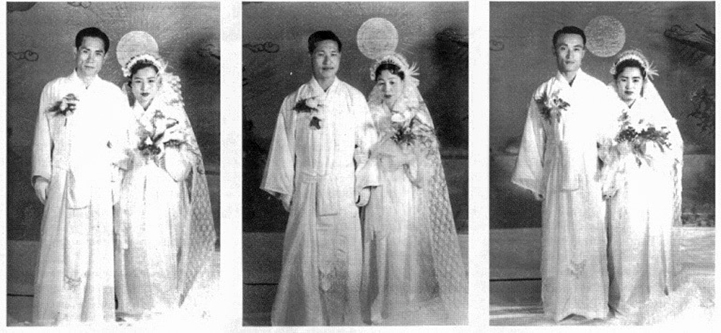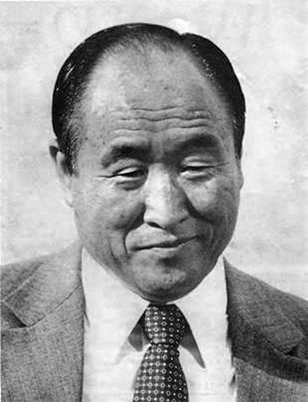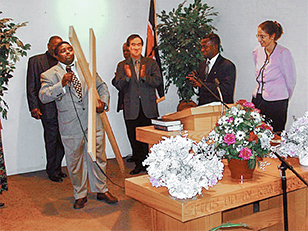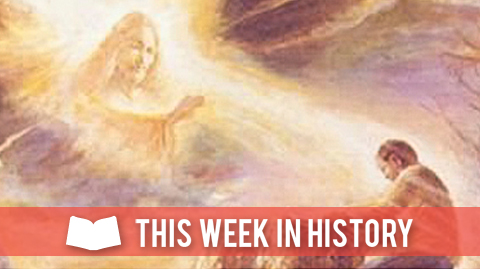The New Historical Vanguard
This week in history, April 12-18:
- 36 Unificationist-born young adult couples receive the Holy Marriage Blessing (April 12, 1986)
- Three couples receive the Holy Marriage Blessing (April 16, 1960)
- True Father declares the end of the first 21-year course (April 16, 1980)
- True Father encounters Jesus on Easter morning (April 17, 1935)
- Clergy takes down crosses (April 18, 2003)
April 12, 1986
36 Couple Unificationist-born Young Adult Holy Marriage Blessing

A new era began for the Unification Church on April 12, 1986, at the Little Angels Performing Arts Center in Seoul when True Parents gave the Holy Marriage Blessing to 36 Unificationist-born couples. This was the first Holy Marriage Blessing of Unificationist-born young adults apart from the Marriage Blessings of four of True Parents’ own children. On April 8, True Father called candidates in Korea to assemble and began the matching engagement, which continued into the following day. Unificationist-born candidates outside Korea were matched by photograph. Those participating were the sons and daughters of Unificationists who had participated in the 36-, 72-, and 124-Couple Blessings. Through the marriage of their children these early Unificationists became relatives.
In his message to the newly engaged couples, “The New Historical Vanguard,” True Father described the occasion as “an amazing providential event.” He called upon the young couples to “renew the true tradition of the Unification family” by being “standard-bearers … for the sake of all the people of the world.” He also asked them to “learn the historical lesson” from the Israelites who perished after returning to Canaan “by aiming at worldly goals requiring knowledge, money and power.” Finally, he called upon them to be “victorious over the entire world” by going “through suffering that no one else in the world can handle.” He advised them to “find the abandoned path that the people of this world would consider worthless. That is the path God is asking you to walk.”
April 16, 1960
Three Couples Holy Marriage Blessing

On April 16, 1960, the fifth day following True Parents’ Holy Wedding, True Parents blessed three couples in Holy Matrimony. They were Kim Won-pil and Chung Dal-ok; Eu Hyo-won and Sa Gil-ja; and Kim Young-hwi and Chung Dae-hwa. There were a number of providential conditions connected to these couples. True Father noted that they represented the families of Adam, Noah and Abraham. They also were chosen as the resurrected figures of Cain, Abel and Seth in Adam’s family. In addition, they were in the position of Jesus’ three main disciples and restored archangels. True Father stated that he required “three disciples” in the position of spiritual children “who will be loyal to him and follow him through persecution, even at the risk of their lives” as a condition for his Holy Wedding. True Father, thereby, engaged the three couples ahead of his wedding. One of the couples had been previously married, one had been previously engaged, and one was “matched” immediately before their engagement. In this way, they were intended to represent all marital situations. The three couples joined 33 additional couples who were blessed in marriage the following year as the Unification Church’s original 36 couples.
April 16, 1980
True Father Declares the End of the First 21-Year Course

Unification theology teaches that the course of creation and restoration unfolds according to the three stages of formation, growth and perfection. True Father applied that principle in conducting his ministry. He initially applied it to his individual course upon embarking on his public ministry after World War II. The 21-year course with which Unificationists were most familiar followed True Parents’ Holy Wedding in 1960. True Father described how True Parents walked a family-level course for seven years, followed by a national-level course in which the Unification tradition stabilized itself within Korea, and then a worldwide course during which True Parents planted Unificationism globally. True Father declared that 21-year course to be completed on Parents Day, April 16, 1980. He said that it was to be followed by another 21-year course centered on Unification blessed families. This course, he noted, would be centered first upon deterring the advance of communists and then liberating them. To do so, he said Unificationists must “be superior in God-centered character and in strength of knowledge, experience and organization.” The new 21-year course would be centered upon “Home Church,” which True Father described as the methodology to “liberate the entire world centered on the true love of God.”
April 17, 1935
True Father’s Easter Revelation

In his autobiography, As a Peace-Loving Global Citizen, True Father traces circumstances that led to his profound encounter with Jesus on Easter morning, 1935. In particular, he notes his exposure to suffering which included the suffering of Korea under Japanese colonial authorities and his family’s suffering, which included the loss of five younger siblings during his fifteenth year. From this time, True Father began to immerse himself in prayer, often at desolate locations. He recounts, “The night before Easter in the year I turned sixteen, I was on Mount Myodu praying all night and begging God in tears for answers.” Then, in the early morning, having spent the entire night in prayer, True Father stated that “Jesus appeared before me … in an instant, like a gust of wind, and said to me, ‘God is in great sorrow because of the pain of humankind. You must take on a special mission on earth having to do with Heaven’s work.’”
True Father said that Jesus’ manifestation “caused my body to shake violently, like quaking aspen leaves trembling in a strong breeze.” He said he was “simultaneously overcome with fear so great I thought I might die and gratitude so profound I felt I might explode.” Jesus, he recounted, “spoke clearly about the work I would have to do … saving humanity from its suffering and bringing joy to God.” True Father said he was “truly afraid.” He wanted “somehow to avoid this mission” and remembers, “I clung to the hem of his clothing and wept inconsolably.”
April 18, 2003

Clergy Take Down Crosses
True Father believed that “deep-rooted conflict between major religious traditions” constituted the background of “violent wars all over the world. It followed that religious leaders should take the initiative in restoring peace. This lay behind True Father’s proposal for an interreligious assembly or council at the United Nations. It also undergirded his thinking about the Middle East. True Father taught that Christian, Jewish and Muslim leaders should resolve their differences as a condition for the cessation of violence. However, this necessitated that Christian clergy acknowledge that “the era of the cross” had passed and, in fact, remove their crosses, which had been a barrier between the first and second Israel.
The “Take Down the Cross” initiative crystallized in early 2003. In February, True Father asked Unification Church and American Clergy Leadership Conference leaders to educate Christian clergy in Unification theology. At the beginning of March, he called upon clergy to remove crosses from their churches. The goal was that on April 18, Good Friday, 120 ACLC clergy nationwide would have a public ceremony to take down the cross. That goal was met. As reported by Michael Jenkins, who at the time was the president of HSA-USA: “123 clergy took down their crosses over the Easter weekend … supported by another 135 clergy. … All told, 258 clergy directly affirmed the taking down of the cross, proclaiming an end to the era of bloodshed and sacrifice and the beginning of a new era of faith and resurrection.” Though controversial in some quarters, their action launched the Middle East Peace Initiative (MEPI) which brought 10,000 clergy and Ambassadors for Peace to the Holy Land over the following two years.
Contributed by Dr. Michael Mickler, professor of church history at Unification Theological Seminary.

